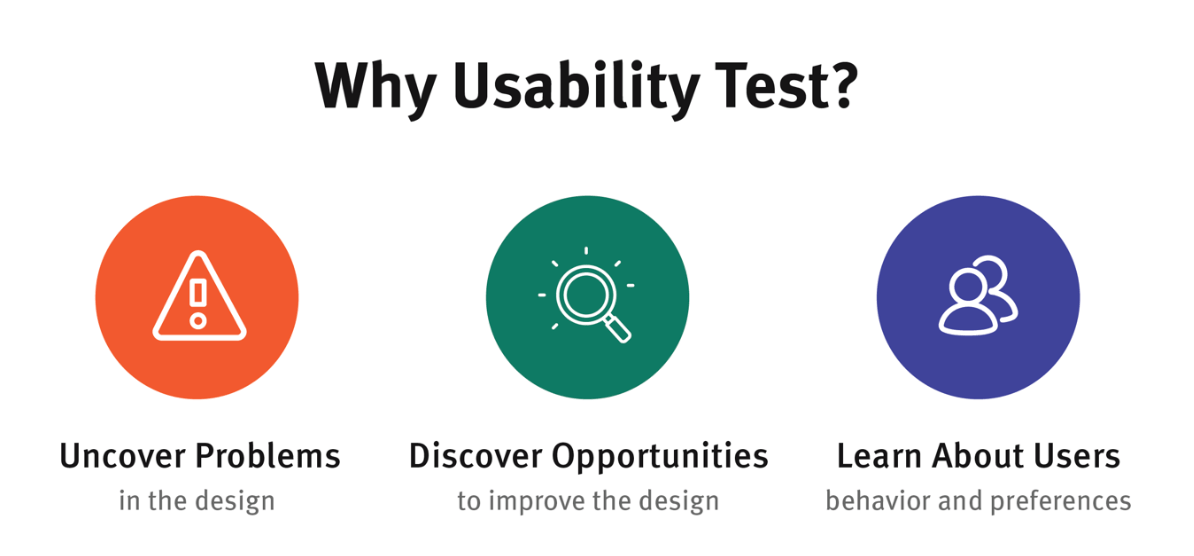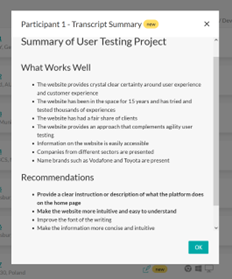As a website owner or designer, you know the importance of creating a website that is easy to use and provides a positive user experience. However, creating a website that is both visually appealing and easy to navigate can be a challenging task. That’s where user testing comes in. User testing is the process of gathering feedback from real users to test the usability of your website. The future of UX design will incorporate artificial intelligence to better understand user needs and maximize the usability of your website.
Loop11 has introduced the power of artificial intelligence into user testing by leveraging OpenAI’s GPT-3 technology. Loop11 is able to provide instant insights from user test data. It is able to generate AI summaries of audio transcriptions from every participant you test with to provide a quick and easy way to understand the results, including design recommendations for improvement. Loop11’s AI user testing tool will be able to analyze the results of each task, the participant summaries, and the analytics from the Loop11 report to provide even deeper user insights.
In this article, we’ll cover the step-by-step process for maximizing your website’s usability with user testing. We’ll start by outlining the reasons why user testing is crucial for website usability, and then provide a comprehensive guide on how to conduct user testing on your website to maximize usability. By following our guide, you’ll be able to make informed decisions about website design and development based on data from user testing, ultimately improving the user experience and engagement on your website. So let’s get started!
What is User Testing?
User testing is the practice of gathering feedback and insights from your users in order to improve the overall usability of a website. It involves observing users as they navigate through a website while they complete specific tasks, by recording their feedback and reactions. By conducting user testing, you can gain valuable insights into how your users interact with your website and identify areas where improvements can be made to enhance the user experience. This can lead to improved website findability, better information architecture, and ultimately, a website that is more effective at achieving your business and user goals. User testing can also help in benchmarking, A/B testing, mobile testing, prototype testing, and other stages of the design process.
The Benefits of User Testing
The benefits of user testing are numerous. Firstly, it can help to improve the overall user experience. By collecting feedback from your users, you can identify pain points in your website’s design and functionality and make changes to improve their experience. By testing your website with users you will be able to move the needle on core UX metrics such as user satisfaction, engagement, and loyalty, which in turn can help to improve your website’s search engine rankings and drive more traffic to your site.
Additionally, user testing can lead to better user retention. By addressing the issues identified through user testing, you can provide your users with a better overall experience and encourage them to return to your site in the future. This can help to build a loyal user base and increase your website’s overall success.
User testing can also lead to increased conversion rates. By identifying and addressing the issues that are preventing users from completing primary tasks on your site, such as making a purchase or filling out a form, you can optimize your site to increase the likelihood of these actions being carried out intuitively by your users (no outside help needed). This can ultimately lead to increased revenue and business success.
Finally, user testing is a cost-effective way to identify issues with your website. By conducting user testing, you can catch potential issues early on in the design process, before they become major problems that require expensive redesigns or other solutions. This can save you both time and money in the long run.
Planning for User Testing
User testing can be a powerful tool for optimizing your website’s usability, but it requires careful planning to be effective. I always start with a research plan to set clear objectives and goals for the test. This involves identifying what you want to learn and achieve from the test. By having specific and measurable objectives, you can ensure that the test is focused and targeted.
Defining Objectives and Goals
Common website usability goals include improving website findability, optimizing information architecture, and enhancing the mobile experience. Once the objectives and goals are established, the next step is to identify the target user group.
Identifying Target User Group
Understanding your target audience is crucial to ensure that the test provides relevant and valuable insights. You should select participants who are representative of your target audience to get accurate results. If you test with the wrong user group you could end up with a lot of ‘noise’ and irrelevant data. Select your user group based on factors such as the demographics, user behaviors, and preferences to identify your target user group
Creating a Test Plan
Creating a comprehensive test plan is essential for conducting user testing effectively. You should decide on the type of user test to be conducted and determine what tasks the participants will perform during the test. There are several types of tests to consider to maximize the usability of your website including online usability testing, A/B testing, prototype testing, and benchmarking. When planning the test, consider factors such as the number of participants needed, the test environment, and the equipment required.
Loop11’s new features make it easy to create a test plan by allowing you to select from pre-built test templates or create your own customized test. The platform is user-friendly and intuitive for creating and managing tasks, questions, and participant recruitment.
Recruiting Participants
There are several methods for recruiting participants, including using social media, email lists, and online communities. Loop11’s new features provide an automated participant recruitment system that allows you to target specific demographics and user behaviors. Incentivizing participation is also important to ensure that participants are motivated and engaged during the test. Incentives can include gift cards, discounts, or other rewards.
Conducting User Testing
Preparing for the Test
Before conducting a user test, it is important to ensure that the testing environment is set up correctly. This includes making sure that the website is working properly and that all necessary equipment and software are ready to go. Clear instructions should be provided to participants before the test begins to ensure that they understand what is expected of them. I like to run a pilot session to ensure that all the testing environment is functioning as expected.
Conducting the Test
When conducting the test it is important to avoiding leading questions or cues, allowing participants to complete tasks on their own, and avoiding interruptions or distractions. Observations and data should be recorded consistently to allow for accurate analysis later on.
Analyzing the Results
Once the test is complete, the data collected needs to be analyzed to identify patterns and insights that can inform website improvements. This includes identifying areas where users struggled, such as with navigation or findability, as well as identifying what worked well. Loop11’s new AI-powered features can help with this process by analyzing results of each task, participant summaries, and analytics to provide a comprehensive summary report with key findings and design recommendations.
By following these steps and leveraging the power of user testing and tools like Loop11’s AI-powered platform, website owners and designers can maximize website usability and user experience, leading to increased user satisfaction, engagement, and conversion rates.
Implementing Changes Based on User Testing Results
Once you have analyzed the results of your user testing, it is important to prioritize the changes you want to make so that you are making effective changes that will move the needle on your prioritized UX metrics that you highlighted in your research plan.
Prioritizing Changes
Loop11’s analysis tools can help you identify areas of your website that are causing users difficulty and prioritize changes accordingly. If you prefer to go the manual route you can start by considering which change will have the greatest impact on improving the user experience (i.e fixing a usability catastrophe) and which change will help you achieve your website usability goals. I like to get my product manager involved to agree on the category rankings to help prioritize the changes we want to make on the product. It is also important to ensure that any changes you make are in line with your website’s brand identity and messaging.
Making Effective Changes
Once you have identified the areas that need improvement and have prioritized the changes to be made, the next step is to actually make the changes. One key aspect of making effective changes is to use the insights gained from user testing to inform the design process. For example, if user testing has revealed that participants had difficulty finding certain information on the website, the design team should focus on improving the information architecture and navigation to make it easier for users to find what they need.
I like to involve stakeholders and the development team in the process of implementing changes. This can help ensure that the changes are feasible and that everyone is on board with the proposed changes. In addition, involving the development team early on can help identify potential technical issues that may arise during the implementation process.
Measuring the Impact of Changes
After implementing changes based on user testing results, it is essential to measure their impact on the website’s usability and user experience. This involves comparing the website’s performance before and after the changes and analyzing user feedback.
One effective way to measure the impact of changes is through A/B testing, which involves showing two versions of the website to users and analyzing their behavior and feedback. For example, if you made changes to the website’s navigation menu, you could conduct an A/B test to compare the performance of the old and new versions.
Conclusion
In conclusion, user testing is a crucial process in maximizing a website’s usability and improving the user experience. It involves gathering feedback from real users to test the usability and effectiveness of a website, and Loop11’s AI technology has made this process easier and more efficient for website owners and UX designers. The benefits of user testing include improved user experience, increased user retention and conversion rates, and cost-effectiveness. Planning for user testing involves defining objectives and goals, identifying the target user group, creating a test plan, and recruiting participants. Finally, conducting user testing involves preparing for the test, conducting the test, and analyzing the results. By following these steps, website owners and designers can gain valuable insights to make informed decisions and improve their website’s overall effectiveness.
![]() Give feedback about this article
Give feedback about this article
Were sorry to hear about that, give us a chance to improve.








